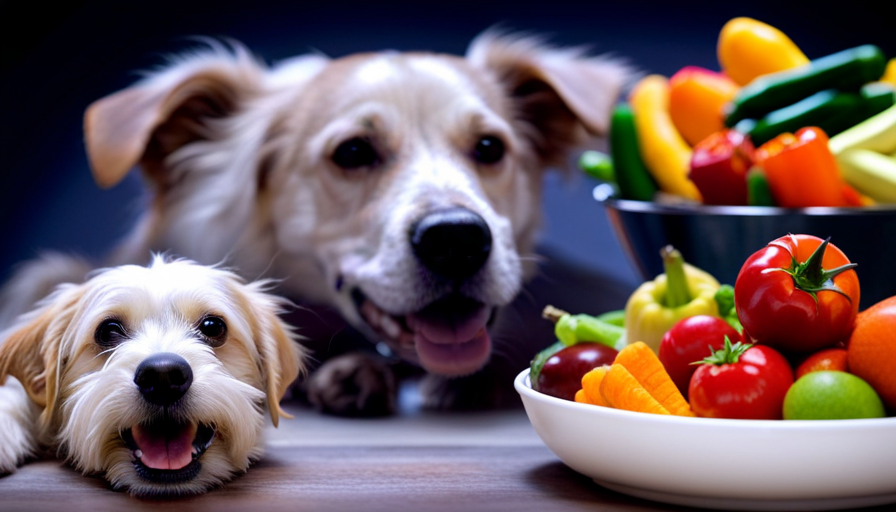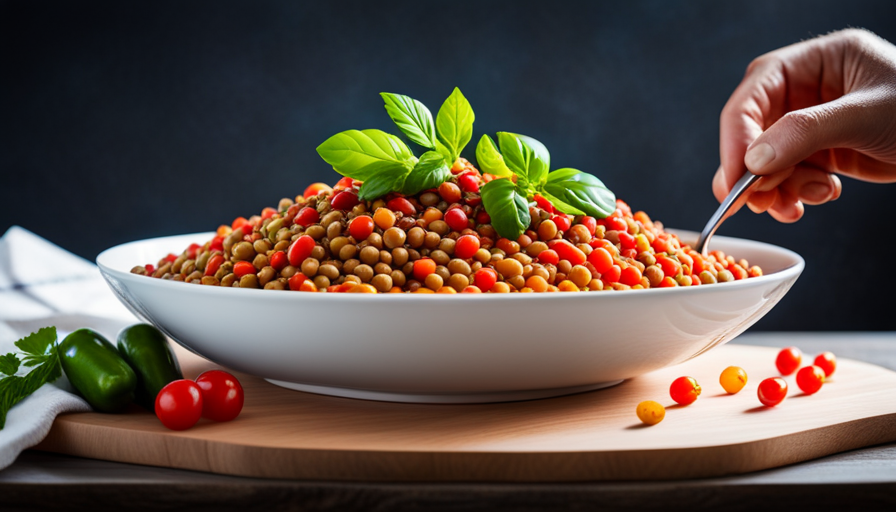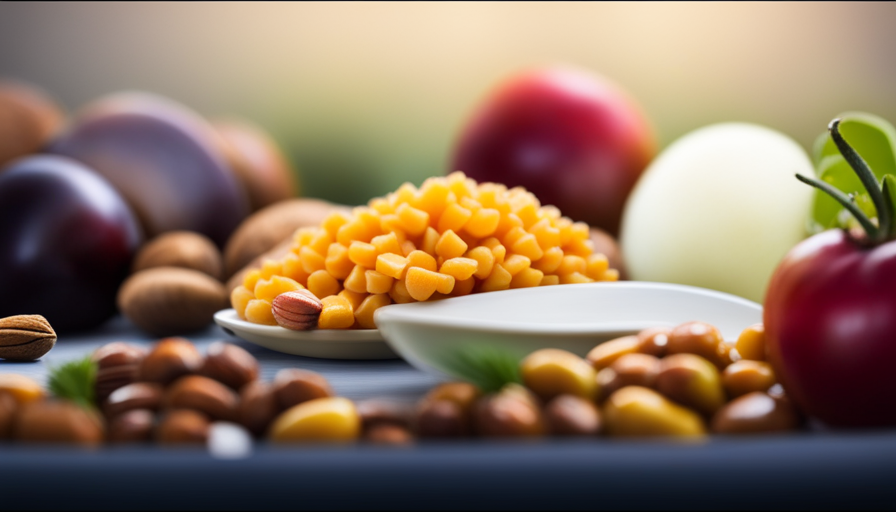Have you ever excitedly planned a meal, only to discover that your raw food is frozen solid? It’s a frustrating scenario that many of us have experienced. As a food lover and passionate chef, I recognize the significance of thawing raw food properly before cooking. It’s not only about convenience, but also about guaranteeing the optimal taste and texture.
Imagine this: you’re standing in front of your freezer, staring at a block of frozen meat. It’s as hard as a rock, and you wonder how long it will take to thaw. Like a sculptor chiseling away at a block of marble, you need to carefully and patiently thaw your raw food to achieve the perfect result.
In this article, I will guide you through the thawing process for various types of raw food, including meat, fish, vegetables, fruits, and baked goods. I will provide you with the best practices, timeframes, and techniques to ensure your food thaws evenly and safely.
Get ready to unlock the secrets of perfectly thawed food every time!
Key Takeaways
- Thawing raw food before cooking is important for taste and texture.
- Thawing poultry should be done in the refrigerator, allowing 24 hours for every 2 to 3 pounds of meat.
- Thawing fish should be done in the refrigerator or using the cold water thawing method, changing the water every 30 minutes.
- Thawed food should be used promptly and leftovers should be stored properly.
Understanding the Thawing Process
The key to safely thawing raw food is understanding the time it takes for it to unfreeze. Thawing frozen meals and defrosting bread require different approaches due to their varying compositions and moisture content.
When it comes to thawing frozen meals, it’s essential to plan ahead. The best method is to transfer the frozen meal from the freezer to the refrigerator and let it thaw slowly overnight. This gradual process ensures that the food stays at a safe temperature throughout, preventing bacterial growth.
On the other hand, defrosting bread can be done at room temperature or using a microwave. To defrost bread at room temperature, simply place it in a paper bag or wrap it in a clean kitchen towel and leave it for a couple of hours. If you’re in a hurry, you can use a microwave on the defrost setting, but be careful not to overheat it, as this can make the bread tough and dry.
Now, let’s dive into thawing meat: best practices and timeframes.
Thawing Meat: Best Practices and Timeframes
When you’re ready to thaw your meat, it’s important to know the best practices and timeframes to ensure a delicious and safe meal. Proper thawing techniques are crucial to maintain the quality and integrity of the meat.
For thawing poultry, it’s recommended to place it in the refrigerator, allowing approximately 24 hours for every 2 to 3 pounds of meat. This slow and controlled thawing process ensures that the meat remains at a safe temperature throughout.
On the other hand, defrosting steak can be done using the refrigerator method or by submerging it in cold water. If using the water method, make sure to change the water every 30 minutes to prevent bacterial growth. Generally, it takes about 30 minutes per pound for steak to thaw using this method.
Following these best practices will not only yield a tasty meal but also minimize the risk of foodborne illnesses. Thawing meat slowly and at the proper temperature allows for even defrosting and prevents the growth of harmful bacteria.
Now, let’s transition into the subsequent section about thawing fish: tips and techniques.
Thawing Fish: Tips and Techniques
Get ready to unleash your culinary skills and dive into the world of thawing fish: the secret to unlocking a sea of delectable flavors and mouthwatering dishes! When it comes to thawing fish, it’s important to follow proper defrosting techniques to ensure the best results.
Here’s how to thaw fish properly.
First, it’s crucial to always thaw fish in the refrigerator. This slow thawing method allows the fish to defrost evenly and prevents the growth of harmful bacteria. Simply place the fish in a sealed container or wrap it tightly in plastic wrap to prevent any cross-contamination.
If you’re short on time, you can also use the cold water thawing method. Place the fish in a leak-proof plastic bag and submerge it in cold water. Change the water every 30 minutes to maintain a safe temperature. Remember to never use warm or hot water as it can lead to uneven thawing and compromise the texture of the fish.
Once the fish is fully thawed, it’s important to use it immediately or store it in the refrigerator for no more than two days. This ensures optimal freshness and quality.
Now that you know how to thaw fish properly, it’s time to move on to the next section about thawing vegetables: methods and timing. Mastering the art of thawing different ingredients will elevate your cooking skills to new heights.
Thawing Vegetables: Methods and Timing
Explore the world of thawing vegetables and unlock a burst of vibrant flavors and tantalizing textures in your dishes! Thawing leafy greens and root vegetables requires careful consideration to ensure their quality and taste.
Leafy greens, such as spinach and kale, can be thawed by simply transferring them from the freezer to the refrigerator. This slow thawing process allows the greens to retain their nutrients and crispness.
On the other hand, root vegetables like carrots and potatoes can be safely thawed by placing them in cold water. This method helps to preserve their natural flavors and textures.
When thawing leafy greens, it’s important to handle them gently to prevent any damage or bruising. Once thawed, these greens can be used in salads, stir-fries, or sautés.
Thawing root vegetables, on the other hand, requires a bit more time and patience. It’s recommended to keep them submerged in cold water for a few hours until they become pliable.
With these thawing methods, you can bring the freshness and goodness of vegetables to your table, even during the winter months. Now, let’s move on to thawing fruits: recommendations and timelines, to continue our culinary journey.
Thawing Fruits: Recommendations and Timelines
When it comes to thawing fruits, there are specific recommendations and timelines to follow.
Thawing berries should be done gradually in the refrigerator to maintain their texture and flavor.
Citrus fruits, on the other hand, can be thawed at room temperature or under running water.
Lastly, tropical fruits should be thawed in the refrigerator to prevent any loss of flavor or texture.
Thawing Berries
Thawing berries can be done quickly in the microwave, but is it the best method for preserving their flavor and texture? While microwaving berries may be a convenient option, it can lead to a loss of flavor and a mushy texture. Quick thawing methods, such as using a microwave, can cause the berries to become overcooked and lose their natural sweetness.
To preserve the optimal flavor and texture of berries, it’s recommended to thaw them slowly in the refrigerator. This gradual thawing process allows the berries to retain their natural taste and firmness.
Now, let’s transition to the next section about thawing citrus fruits, where we’ll explore the best methods for preserving their juiciness and tanginess.
Thawing Citrus Fruits
Indulge your taste buds with the lusciousness of thawed citrus fruits, as their tangy juiciness bursts with refreshment. Thawing lemons is a simple process that involves placing the frozen fruit in the refrigerator overnight or under cool, running water for a few minutes.
Once thawed, the lemons can be used in various recipes, from zesty dressings to flavorful desserts. Freezing oranges is also possible, but the process may affect their texture and juiciness. To thaw frozen oranges, it’s recommended to leave them in the refrigerator overnight. Alternatively, you can thaw them under cool water for a few minutes.
The resulting thawed oranges can be enjoyed as a refreshing snack or used in smoothies and citrus-infused dishes.
Transitioning to the subsequent section about thawing tropical fruits, let’s explore the exotic flavors waiting to be unleashed.
Thawing Tropical Fruits
When it comes to thawing citrus fruits, the process is relatively simple and straightforward. However, thawing tropical fruits like mangoes and pineapples requires a bit more care and attention. These fruits have a higher water content and are more delicate, so it’s important to thaw them properly to maintain their texture and flavor.
To thaw mangoes, place them in the refrigerator overnight or use the defrost function on your microwave, making sure to stop and check on them frequently to avoid overcooking. For pineapples, it’s best to leave them at room temperature until they’re partially thawed, and then transfer them to the refrigerator to finish thawing completely.
Thawing tropical fruits can take anywhere from a few hours to overnight, depending on their size and ripeness. Once thawed, they can be enjoyed as is or used in various recipes.
Now, let’s move on to the next section about thawing dairy and eggs: techniques and timeframes.
Thawing Dairy and Eggs: Techniques and Timeframes
When it comes to thawing dairy and eggs, it’s important to follow proper techniques and timeframes to ensure the safety and quality of the food. Thawing milk and cream should be done in the refrigerator and may take anywhere from 24 to 48 hours.
Cheese can also be thawed in the refrigerator, but it may take longer than milk and cream, depending on the type of cheese.
Eggs should be thawed in the refrigerator as well and can take around 12 to 24 hours.
By following these guidelines, you can safely thaw dairy and eggs while preserving their taste and texture.
Thawing Milk and Cream
Thawing milk and cream can take a little while, but it’s worth the wait for that creamy goodness. When it comes to thawing butter, it’s recommended to transfer it from the freezer to the refrigerator and allow it to thaw slowly. This process can take anywhere from a few hours to overnight, depending on the size of the butter.
On the other hand, defrosting ice cream should be done in the refrigerator as well, allowing it to soften slowly. This usually takes about 30 minutes to an hour, depending on the temperature of your refrigerator.
As for thawing cheese, it’s best to follow similar guidelines as butter, allowing it to thaw in the refrigerator for several hours. Moving on to thawing cheese…
Thawing cheese requires a different approach, as it is sensitive to temperature changes.
Thawing Cheese
To bring the deliciousness of cheese back to life, just let it slowly thaw in the refrigerator. Thawing cheese is best done in the refrigerator to maintain its texture and flavor.
Avoid thawing soft and fresh cheeses like ricotta or cottage cheese, as they tend to become grainy and watery when thawed. Hard and semi-hard cheeses like cheddar, Swiss, and Parmesan can be successfully thawed in the fridge. Simply place the wrapped cheese in a dish or on a plate to catch any moisture that may accumulate during the thawing process.
Thawing cheese at room temperature or in the microwave can lead to undesirable changes in texture and flavor.
Now, let’s move on to the next section about thawing eggs.
Thawing Eggs
Thawing cheese is one thing, but thawing eggs requires a different approach. When it comes to thawing eggs, it’s important to follow proper egg storage recommendations.
Eggs should be stored in the refrigerator at a temperature between 33°F and 40°F to maintain their freshness and quality. If you need to thaw eggs, it’s recommended to transfer them from the freezer to the refrigerator and allow them to thaw slowly overnight. This gradual thawing process helps preserve the texture and taste of the eggs.
Once thawed, it’s important to use the eggs promptly and avoid refreezing them.
Now, let’s move on to the next section where we’ll explore the methods and recommendations for thawing baked goods.
Thawing Baked Goods: Methods and Recommendations
When you’re craving a warm, gooey chocolate chip cookie, it’s like waiting for a butterfly to emerge from its cocoon – the anticipation builds as you let it thaw before devouring its deliciousness.
Thawing baked goods, such as pastries and bread, requires careful consideration to ensure optimal taste and texture. Here are four recommended methods for thawing these delectable treats:
-
Room temperature: Allow the baked goods to thaw naturally at room temperature. This method may take a few hours but ensures even thawing without compromising the texture.
-
Microwave: For a quicker thaw, place the baked goods on a microwave-safe plate and use the defrost setting. Keep a close eye on them to prevent overheating or drying out.
-
Oven: Preheat the oven to a low temperature (around 300°F) and place the frozen baked goods on a baking sheet. Check them frequently to avoid overcooking.
-
Refrigerator: If you have time, thawing in the refrigerator is the safest option. Place the baked goods in a covered container and let them thaw overnight. This method preserves the texture and flavor.
Thawing baked goods requires patience and proper technique, but the end result is well worth the wait.
Now, let’s dive into some tips and tricks for quick thawing.
Thawing Tips and Tricks for Quick Results
Ready to indulge in your favorite baked goods without the wait? Here are some quick and clever tips for achieving speedy thawing results.
When it comes to thawing fruits, it’s important to preserve their nutrients. To do this, opt for the refrigerator method. Simply transfer the frozen fruits from the freezer to the fridge and let them thaw slowly overnight. This method helps retain the fruits’ natural flavors and nutrients, ensuring a delicious and healthy treat.
When thawing meat, it’s crucial to prevent bacterial growth. The best way to do this is by using the cold water method. Place the frozen meat in a leak-proof plastic bag and submerge it in cold water. Change the water every 30 minutes to maintain a constant temperature. This method allows for a quicker thawing process while minimizing the risk of bacteria multiplying.
These thawing tips and tricks are not only time-saving but also ensure the safety and quality of your food. Once your baked goods are thawed, it’s important to consider safety considerations and storage guidelines. This includes properly storing any leftovers in airtight containers and adhering to recommended storage times. By following these guidelines, you can enjoy your thawed treats with peace of mind.
Safety Considerations and Storage Guidelines
To ensure the utmost safety and maintain the freshness of your delectable treats, it’s essential to consider the proper storage guidelines and take necessary precautions. When it comes to thawing raw food, safety should be a top priority. One must always remember to follow certain safety precautions to prevent the growth of harmful bacteria that can cause foodborne illnesses.
First and foremost, it is crucial to thaw raw food in the refrigerator. This slow thawing method allows for a gradual and even thaw, minimizing the risk of bacterial growth. It is recommended to place the food on a plate or in a container to catch any liquid that may drip. The table below highlights the recommended storage times for various types of raw food in the refrigerator:
| Type of Raw Food | Refrigerator Storage Time |
|---|---|
| Poultry | 1 to 2 days |
| Red Meat | 3 to 5 days |
| Seafood | 1 to 2 days |
Additionally, it is important to keep raw food separated from ready-to-eat foods to avoid cross-contamination. Raw food should be stored in leak-proof containers or sealed plastic bags to prevent any contact with other foods.
By following these safety guidelines and storage recommendations, you can ensure the integrity and quality of your thawed raw food. In the next section, we will explore how to achieve perfectly thawed food every time.
Conclusion: Perfectly Thawed Food Every Time
Achieve the ultimate culinary experience by ensuring your delectable treats are perfectly thawed every time, resulting in a mouthwatering meal that’ll transport your taste buds to gastronomic paradise.
Thawing raw food properly is crucial to maintain its quality and safety. Here are the best ways to thaw your raw food and avoid common mistakes:
-
Plan Ahead: Allow enough time for your food to thaw gradually in the refrigerator. This method ensures a steady and safe thawing process, preventing the growth of harmful bacteria.
-
Cold Water Bath: If you’re short on time, submerge your tightly sealed food in a sink or large bowl filled with cold water. Change the water every 30 minutes to maintain a safe temperature. This method can thaw food faster than the refrigerator but requires monitoring.
-
Avoid the Danger Zone: Never thaw raw food at room temperature as it may enter the danger zone, where bacteria can multiply rapidly. This temperature range, between 40°F (4°C) and 140°F (60°C), promotes bacterial growth and can lead to foodborne illnesses.
By following these guidelines, you can ensure that your raw food is thawed properly, resulting in a safe and delicious meal. Don’t let common mistakes compromise the quality of your culinary creations. Take the time to thaw your raw food correctly and savor the flavors of a perfectly thawed feast.
Frequently Asked Questions
Can I thaw raw meat in hot water?
Thawing raw meat in hot water is not recommended as it can lead to uneven thawing and promote bacterial growth. The best way to thaw frozen meat is to use the cold water method. Simply place the meat in a leak-proof plastic bag and submerge it in cold water, changing the water every 30 minutes.
This method allows for a safe and even thawing process, ensuring the meat remains at a safe temperature throughout.
How long can I leave raw fish out on the counter to thaw?
The best thawing method for raw fish is to place it in the refrigerator overnight. This ensures a slow and safe thawing process. Leaving raw fish out on the counter to thaw is not recommended, as it can lead to bacterial growth and foodborne illnesses. Thawing time will depend on the size and thickness of the fish, but generally, it takes around 24 hours. Remember to always handle raw fish with care to avoid any contamination.
Can I microwave frozen vegetables to thaw them quickly?
Can I microwave frozen vegetables to thaw them quickly?
While it may seem convenient, using a microwave to thaw frozen vegetables is not the best method. Microwaving can result in uneven thawing and may even partially cook the vegetables.
Stovetop thawing is a better option as it allows for more controlled and even thawing.
For quick thawing, the best method is to place the frozen vegetables in a sealed plastic bag and immerse them in cold water.
Is it safe to thaw fruits in warm water?
Thawing fruits in warm water can be a convenient method, but it has its pros and cons. On the positive side, warm water can speed up the thawing process, allowing you to enjoy your fruits sooner. However, it’s important to note that this method can cause some loss of flavor and texture.
Alternatively, you can thaw fruits in the refrigerator overnight or use the defrost setting on your microwave. These methods may take longer, but they help preserve the quality of the fruit.
Can I refreeze raw dairy and eggs after they have been thawed?
Refreezing thawed dairy and eggs is generally not recommended due to safety concerns. When raw food is thawed, bacteria can multiply and cause foodborne illnesses. Refreezing can further enhance bacterial growth, leading to potential health risks. It is best to consume thawed dairy and eggs immediately or cook them thoroughly before refreezing.
To ensure food safety, it’s important to handle raw food with caution and follow proper storage and thawing guidelines.
What is the Best Way to Unfreeze Raw Food Without Compromising its Quality?
When it comes to unfreezing raw food, the best way is to plan ahead and allow the proper freezing raw food timeframe. The recommended method is to thaw the food in the refrigerator, which helps maintain its quality and prevents bacterial growth. Patience is key to preserving the integrity of the raw food.
Conclusion
In conclusion, understanding the proper thawing techniques is crucial for ensuring the safety and quality of our food. By following the recommended timeframes and methods for thawing meat, fish, vegetables, fruits, and baked goods, we can avoid the risks of bacterial growth and maintain the flavors and textures of our favorite dishes.
It’s fascinating to note that, according to a study by the Food and Drug Administration, improper thawing methods contribute to a significant number of foodborne illnesses each year. This statistic serves as a stark reminder of the importance of thawing food correctly to protect ourselves and our loved ones.










